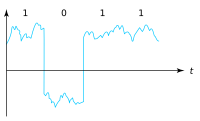
Photo from wikipedia
Fault detection and isolation is an area of engineering dealing with designing online protocols for systems that allow one to identify the existence of faults, pinpoint their exact location, and… Click to show full abstract
Fault detection and isolation is an area of engineering dealing with designing online protocols for systems that allow one to identify the existence of faults, pinpoint their exact location, and overcome them. We consider multi-agent systems, where faults correspond to the disappearance of links in the underlying graph, simulating communication failures between agents. We study the case in which the agents and controllers are maximal equilibrium-independent passive, and use the known connection between steady states of these multi-agent systems and network optimization theory. We first study asymptotic methods of differentiating the faultless system from its faulty versions by studying their steady-state outputs. We explain how to apply the asymptotic differentiation to detect and isolate communication faults, with graph-theoretic guarantees on the number of faults that can be isolated, assuming the existence of a “convergence assertion protocol,” a data-driven method of asserting that a multi-agent system converges to a conjectured limit. We then construct two data-based convergence assertion protocols. We demonstrate our results by a case study.
Journal Title: IEEE Transactions on Automatic Control
Year Published: 2022
Link to full text (if available)
Share on Social Media: Sign Up to like & get
recommendations!